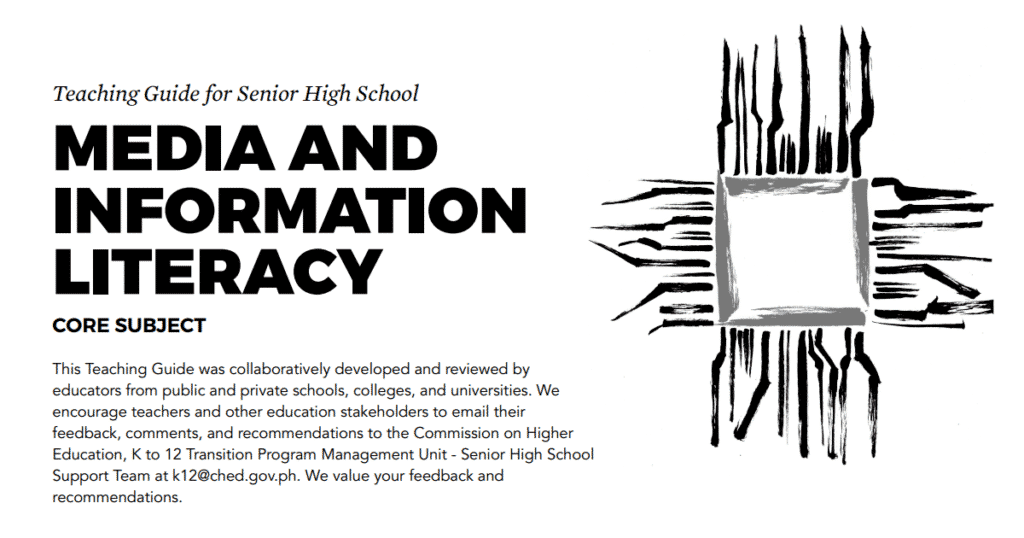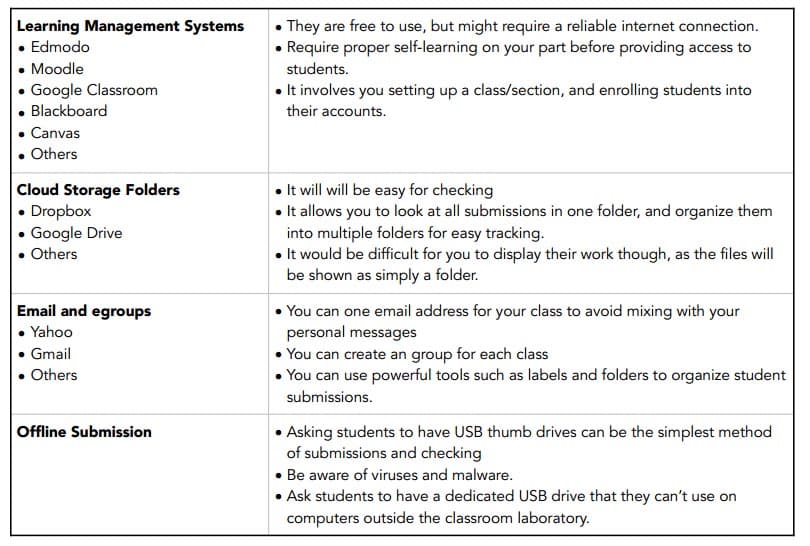Table of Contents
Media and Information Literacy Teaching Guide
UNESCO defines Media and Information Literacy as a set of competencies that empowers citizens to access, retrieve, understand, evaluate and use, to create as well as share information and media content in all formats, using various tools, in a critical, ethical and effective way, in order to participate and engage in personal, professional and societal activities.
The Philippines is among the first country to adapt Media and Information Literacy as part of basic education curriculum. The Department of Education in the new K-12 Basic Education Curriculum included Media and Information Literacy as part of the Core Subjects under the Communication Learning Area for Senior High School (SHS) at Grade 11 or 12 with one semester allocation.
The Media and Information Literacy course introduces the learners to basic understanding of media and information as channels of communication and tools for the development of individuals and societies. It also aims to develop students to be creative and critical thinkers as well as responsible users and competent producers of media and information.
Target Teachers
Primarily, this Teaching Guide is intended to be used by current and future Grade 11 or 12 teachers of Media and Information Literacy. In addition, teachers from all educational levels across all content and subject areas are also welcome to explore it as a guide to integrate technology into their class activities.
Teachers will master (1) prioritizing literacy ; (2) learning and teaching media and information literacy through constructivist approach; (3) becoming competent consumers and producers of information and media resources; and (4) developing digital citizenship and lifelong learning.
Moreover, we envision an MIL teacher with the following qualifications:
- Masters in Education Major in Education Technology or IT/ICT Education or any related field;
- Three-year experience in teaching education technology or T/ICT Education or any related field
- Three-year experience in the analysis, design, development, implementation and assessment of different types of media and information;
- High competencies in online / offline software technologies;
- Highly motivated, outcome-based oriented and life-long learner
Parts and Schedule
The Teaching Guide is based on the MIL Curriculum Guide of DepEd. Each Lesson is divided into two parts: Lecture and Laboratory. The Lecture class has an allocation of 60 minutes and could be delivered inside a traditional classroom although some topics would require a computer with presentation software. The Laboratory class has an allocation of 120 minutes and highly recommended to be conducted inside a computer laboratory with Internet connection. In most Lessons, there is a continuous flow of discussions and activities from the Lecture to Laboratory.
The time allocation is limited to 3 hours (180 minutes) per week compared to the four 4 hours per week in DepEd Curriculum Guide to accommodate schedule changes, unannounced/abrupt class suspensions, and other distractions. Your school might have a different scheduling scheme.
Take note that there are Lessons with two Lecture and Laboratory parts (Motion Media and Information, Manipulatives / Interactive Media and Information, and Multimedia Information and Media).
Media and Information Design
The Media and Information Design Framework aims as a guide in the analysis, design, development, implementation and evaluation of pertinent media and information outputs.
| Components | Guide Questions |
|---|---|
| Target Audience | refers to the the intended audience |
| Sender/Author | refers to the producer / creator of the the media and information |
| Key content | refers to the topic, facts, figures and others used in the media and information |
| Purpose | refers to the reason, motivation or intention of the message. |
| Form/Style | refers to presentation across the different formats guided by design principles and elements: tone, mood, color, font types, manipulation of space, speed, direction, balance, repetition, emphasis, movement, rhythm, unity, contrast, hierarchy, contrast, proportion, alignment, proximity, pattern, others. |
| Medium / Format | refers to the format or platform used in presenting the media and information |
Media and Information Literacy Portal
The use of the MIL Portal is a crucial part of teaching MIL. It refers to the system for submission, checking, tracking, and displaying learners work. Because of the project-based nature of the course, we highly recommend that you use an online platform that can keep all files in a single library. Some recommendations for MIL Portal are listed below.
Electronic Portfolio
The learners would create their own individual personal online page which will be called ePortofolio. An electronic portfolio or ePortfolio is a collection of outputs developed by the learners uploading at an online platform. In recent years, it has become valuable learning and assessment tool. Some recommendations for ePortfolio are listed below.
Blogs and Personal Websites
- Wordpress
- Blogspot
- Tumblr
- Wix
- Others
The learners would decide on the platform their they would use.
It’s a good tool for displaying student submissions publicly, and you can also track students’ progress by going through their individual pages and their body of work
It might be difficult for you to check each submission by going to the students’ personal pages one-by-one so you may want to ask the learners to also submit at MIL Portal all their outputs.


Information and media literacy enables people to show and make informed judgments as users of information and media, as well as to become skillful creators and producers of information and media messages in their own right
/storage/emulated/0/Documents/a651901f-0947-49d9-9d31-68b47c3d9a39.sketchpad.pdf